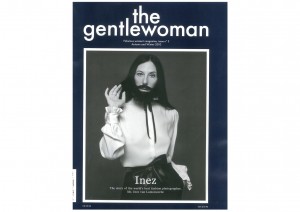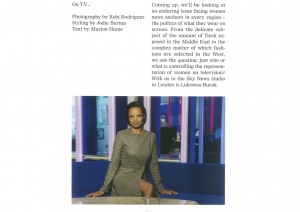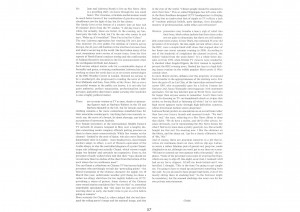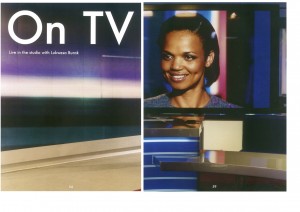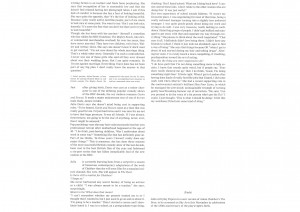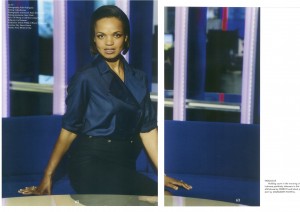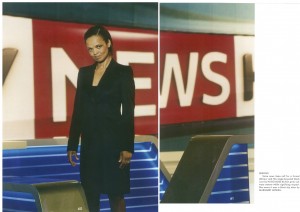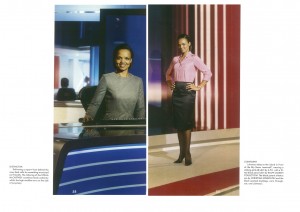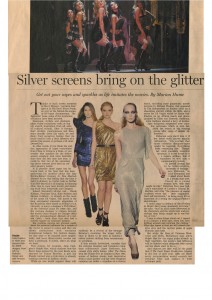Category Archives: Movies
A guide to the 1970s
A guide to the 1970s
Think the Seventies was all about the maxi-dress? Think again. From slick pantsuits to the delicate crepe dresses of Yves Saint Laurent, via the punky pins of rockers’ garbs, this diverse decade has influenced a roll-call of designers for autumn.
BY MARION HUME | 05 OCTOBER 2010
Why are Seventies styles all over the stores right now and, judging by the current round of catwalk shows, staying around next season? Given the original styles were so diverse, there is no short answer. But try these explanations for starters.
Silhouettes and soundtracks
It’s easier to spell out the vast range of looks through sounds of the Seventies. Think Isaac Hayes’s theme from Shaft ; now think Slade; now the Jackson Five; Abba; Rod Stewart; and Bob Marley. If you are old enough, was it Ziggy Stardust segueing into The Sex Pistols for you? Or David Cassidy to Bruce Springsteen? T-Rex to the Jam? Cher’s Gypsys, Tramps and Thieves to The Hustle ?
“The fundamental difference now is the focus on luxe,” says Bridget Cosgrave, fashion director of Matches. Her Seventies memory? “My mother wafting around in silk kaftans to Donna Summer’s I Feel Love .”
It’s all about your mother
The most influential collection of the Seventies – and as important now – was Yves Saint Laurent’s reinvention of memories of his mother, Lucienne, in the crêpe dresses, palazzo pantsuits and platform sandals she wore in the Algerian sun when he was a boy in the Forties. Unfortunately, those styles reminded fashion scribes at his 1971 show of the Nazi occupation of Paris. But just as the old guard hated the collection, the young, like Paloma Picasso, adored it. Those silhouettes were worn by Linda McCartney, the late mother of Stella McCartney, who is in turn now influenced by her mother. As is Phoebe Philo by hers.
“It’s striking how a crop of principally British, thirtysomething designers are re-exploring the easy, chic clothing their mothers once wore,” says Penny Martin, editor-in-chief of the trendy magazine, The Gentlewoman . “Several of them – Phoebe Philo at Céline and Stella McCartney, for instance – are now working mothers themselves and recognise the need for clothes that don’t make them look idiotic. The palette – caramels, flesh tones, pragmatic black and white – as well as generous silhouettes inspire confidence and warmth in those wearing them. Women genuinely look and feel great in these clothes.”
Teenage kicks
Many designers were teenagers in the Seventies, and you never forget your first fashion love. A 17-year-old Tom Ford moved to New York City just as Halston was at his height. At Ford’s womenswear comeback this September, “the ambience of the showing was pure Halston,” says Kate Betts, contributing editor to Time .
Marc Jacobs was familiar with the best designs of the Seventies; aged 15, he started working at Charivari, then Manhattan’s most cutting-edge boutique. Meanwhile, Stefano Gabbana was yearning to afford more than just the stickers at Milan’s Fiorucci. Albert Kriemler now helms his family’s label, Akris. When he was a teen, his father was producing clothes for the ultimate Seventies label, Ted Lapidus – clothes which influence the slim silhouettes in mustard and burgundy in Kriemler’s collections today.
First love never dies for the shopper, too. In 1976, Mimma Viglezio looked so great in her Lee Cooper burgundy corduroy flares, she won the “Miss Arse” competition at her Swiss high school. “It really was called that,” insists the former executive vice-president of Gucci Group, who is now a leading luxury world consultant, adding, “I still love high-waisted flares. When you are not 16 any more and your tummy is not quite so flat, a high waist is more flattering than risking a muffin top!”
Punk
Karen Walker, the designer, was in Auckland rather than New York when CBGB and Studio 54 were at their zenith. “But I love the Seventies as the last age of underground hedonism,” she says. Although the influence of punk has been enormous – there were studs, leather and zips at Balmain last week, set against the sound of Sid Vicious doing My Way – it was a fashion blip at the time. In 1977, Zandra Rhodes somehow made safety pins sweet, but real punks wore Millets and DIY, which is why the rare few who could afford Westwood/McClaren items have since sold them for a fortune.
The thrill of the old
It was in the Seventies that fashion’s looking-backward-to-go-forward dynamic kicked off. In 1971, Cecil Beaton curated an exhibition at the V&A called Fashion, An Anthology , which celebrated styles of previous decades and had the knock-on effect of making wearing vintage smart.
“Today, dealers charge up to £100 for rare and beautiful clothes in perfect condition,” wrote a surprised Georgina Howell in 1975. “Now, in London, you can find a whole range of fashion within a stone’s throw – tweedy, ethnic, Hollywood, classic, glamorous, executive, nostalgic…” Should you be in search of Seventies originals, you’re too late; designer scouts long ago scooped up “inspirational” YSL pie-crust cuff satin blouses. Look for lesser-known labels such as Stephen Burrows or bang-on-the-ethnic-trend Mexicana – Princess Anne packed a Mexicana gown for her 1973 honeymoon.
Celluloid heroines
So to answer how to get the look, well, which look exactly? To narrow it down, you could rent the right films. Everything Julie Christie wears in Don’t Look Now (1973) looks right. Roman Polanski’s Chinatown (1974), although set in 1937, features Faye Dunaway looking very Céline. If you want a Gallic twist, try the early work of French actress Dominique Sanda.
Then there is Lauren Hutton, who began the Seventies as the multi-million-dollar model girl next door, and ended it looking as if she was about to be crushed by the hard-edged Eighties. American Gigolo (made in 1978, released in 1980) is best remembered because Richard Gere’s wardrobe kick-started Giorgio Armani’s dominance in menswear, but it’s Hutton’s flicky hair, blouses and leg-elongating nude mules that are so very now.
The Lost Explorer: Tim Walker’s flight of fancy – The Telegraph Magazine
The Lost Explorer: Tim Walker’s flight of fancy
The Vogue fashion photographer Tim Walker has made a dark film, The Lost Explorer, that features 300 canaries
The Telegraph Magazine | 12 Aug 2010
By Marion Hume
My lemon-curd-and-honey vision just got darker,’ Tim Walker, the fashion-photographer-turned-filmmaker says of his first short film, The Lost Explorer. You may know Walker as the creator of Vogue shoots featuring white rabbits, powder-pink Persian kittens or stately homes covered in balloons. Yet for his first film he was drawn to an unsettling story in the 1989 collection Blood and Water and Other Tales by Patrick McGrath, whom Walker calls ‘the apocalyptic Roald Dahl’. The story begins with a child, Evelyn, played by 14-year-old Olympia Campbell, stumbling on a tent among brambles at the bottom of her garden. Inside, an explorer is dying of malaria and clutching a revolver.
The story the adventurer then whispers to Evelyn comes not from McGrath’s book but from Walker’s memory. ‘Ages ago someone told me how, in Victorian times, there were canary clouds over the Atlantic,’ he says, referring to the days when a taste for exotic birds meant that clippers sailed back from Africa loaded with cages. Halfway home, they would release the birds, which would soar over the sea, until, too tiny to reach land, they would drop back down to the ship and a life of captivity.
Walker was determined to capture this on film. ‘It was the toughest scene,’ he says. ‘We could afford only 300 canaries, and at the end, the animal wrangler retrieved 287. He put down nuts and seeds and five more appeared, then another seven. By the time the last one came down, it was dusty brown from being up in the rafters.’
According to Robbie Ryan, the Irish cinematographer who worked on Andrea Arnold’s Fish Tank, whom Walker employed as director of photography, ‘300 canaries can look like three on film.’ He jokes that he had to pay them double to fly round twice. ‘Tim’s a breath of fresh air, though,’ he adds. ‘He’s so open and he was sponging it all up, because his day job is nothing compared to being on a film set.’
While a normal day for Walker might involve staging a shoot in an art deco mansion in India that hasn’t been used since the days of the Raj, the challenges of film proved much greater. ‘I’ve always been about building the story through the visuals, and I had to learn to sacrifice some visuals to tell the story.’ As for his decision to hire someone else to hold the camera, he told me, ‘That was weird, but I knew I needed to see the whole picture. Robbie’s about realism, and when you mix that with the way I view the world, you get magical realism, and we both were so excited by that. My photography can be so sweet and it needed someone to push things the other way.’
Making the 20-minute film seemed like an epic in itself: ‘I wanted to launch straight into a feature film, but friends said, “No, you’ll get drowned,” ‘ Walker says. ‘I was thinking, “I can do big epic fashion shoots, what’s the difference?” But they were so right, in every way.’ The shoot lasted eight days with a cast of six and a crew of more than 40.
The story is simple: disgusted yet fascinated by the Lost Explorer, played by a craggy, dirty-looking Richard Bremmer (Lord Voldemort in Harry Potter and the Philosopher’s Stone), Evelyn befriends him, keeping his existence, death and burial a secret from her parents. It is a fairy tale with a gently shocking end but it is filled with elements of Walker’s imagination, from shadows of moths fluttering against the tent to close-ups of Evelyn dreamily playing among the sheets on the washing-line. And, of course, there is the ghost-ship scene with the canaries.
Shona Heath, who has created the sets for many of Walker’s fashion fantasies, worked as his costume and production designer. This meant finding authentic pre-First World War tent canvas, and liberally applying coffee, honey and Marmite to age props. The key difference between working on the film and on a fashion set was, she says, ‘a lot less Sellotape and glue. You can’t improvise on film. There was one job I did with Tim where I made hats out of cakes, which he took on the plane to Ireland, and not one survived, so I made some paper clover hats instead. But being true to a story means you can’t walk too far off the path, so suddenly a kind of discipline appeared while normally in Tim’s photography the crazier the better.’
Walker was born in 1970 on the Devon-Dorset border, ‘among hedgerows and cliff paths, in the world Cath Kidston has channelled into her empire’. His mother is the cookery writer Lorna Walker (Clever with Cream, The Complete Bread Book), who, together with his late father, Colin Walker, renovated old houses, and he and his older brother Rupert grew up baking, making camps and building dams and tunnels. (Rupert is currently the programme sponsor for Network Rail’s multimillion pound refurbishment of Reading station.)
Walker’s early ambition was to make films, ‘but at art school,’ he says, ‘everyone else was making funny, tight little shorts and I made this 20-minute film and everyone laughed when they weren’t meant to.’ He began his career as a photo­grapher after coming third in a photography competition for the Independent. He then spent a year immersed in the Cecil Beaton archive during an internship at the Cond Nast library and completed a photography degree at Exeter University before spending another year assisting Richard Avedon in New York. His first fashion commission, for the Independent, was joyfully radical. In an era when every young snapper wanted to find another waif-like Kate Moss, he chose a silver-haired senior clad in Oxfam finds.
He shot his first story for British Vogue 15 years ago, at the age of 25, and has since become a regular fixture in the American and Italian editions, too. His fashion photographs have a sense of theatre and magic about them, and he gleefully goes against the grain of all those images of skinny girls looking glum. The pictures always have a sense of narrative.
Walker’s fashion images, collected in the 2008 book Pictures, speak of a world of enchantment & watching the bee tapping against the window, the smell of mothballs in the wardrobe, going through it to Narnia,’ as he puts it. He loves rambling country piles ‘where you can trample on the roses, and inside there’s ticking mattresses stacked up and up and up and the dusty badminton set by the door. In London we know where stuff is because we have so little space, but when I shoot in houses in Northumberland, in Suffolk, people say, “I haven’t been in this room for five years…” ‘
Walker’s own home is over several floors of an industrial building in Shoreditch, east London. Inside, the urban edge is softened with gingham and bunting. Every inch is adorned on the bare brick walls posters of John and Yoko rub shoulders with advertisements for village fêtes, geraniums jostle on window sills with pottery toadstools, and puppets hang from joists.
Walker began filming The Lost Explorer in February and has been editing it with Valerio Bonelli, who worked on Ricky Gervais’s Cemetery Junction; he is also collecting a series of film stills for a new edition of the story. While the budget for a one-day advertising shoot can easily top £100,000, that’s chump change for a film, despite the fact that everyone, even actors of the calibre of Toby Stephens and Dexter Fletcher, who have supporting roles, worked for free. ‘But that was the amount I needed,’ Walker says. ‘I went round to people I’ve worked with for years and begged, “Can you help?” and Mulberry was brilliant.’
The quintessentially British brand will host a London Fashion Week screening of The Lost Explorer in September; it made its debut in Locarno, Switzerland, this week, and will be screened on the international film festival circuit. Gela Nash, one half of the Juicy Couture partnership (Walker shoots its advertising campaigns), also gets honourable mention for her support.
Walker’s next plan is for the feature film he dreams of making. Currently in his sights is Iain Banks’s The Wasp Factory. ‘It has been in and out of being optioned. I don’t know where it’s at now. But that would be the dream project,’ he says.
Walker’s next plan is for the feature film he dreams of making. Currently in his sights is Iain Banks’s The Wasp Factory. ‘It has been in and out of being optioned. I don’t know where it’s at now. But that would be the dream project,’ he says.

